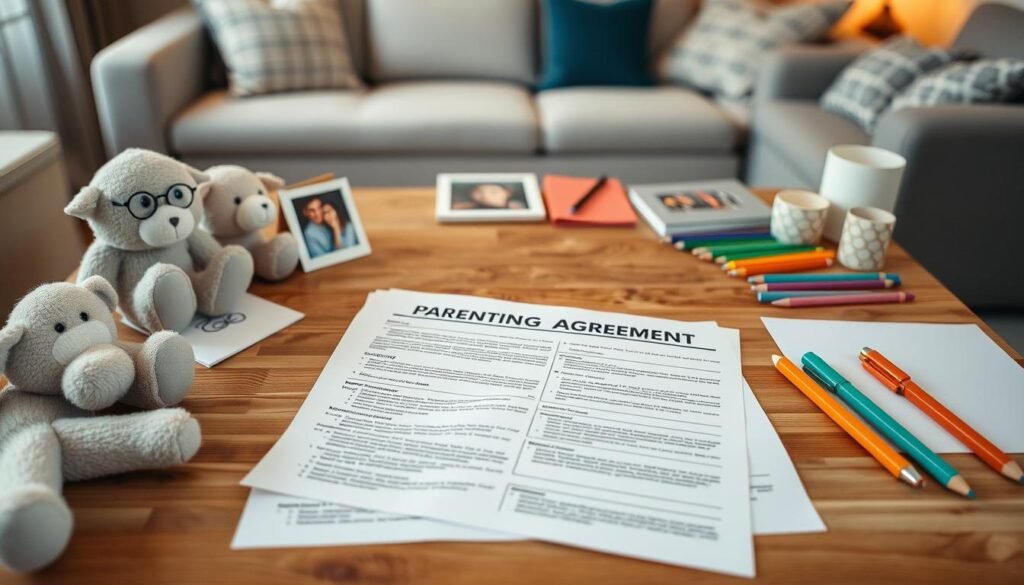Co-parenting can be complex, and you might wonder about parenting agreements. A parenting agreement, or co-parenting agreement, is key. It outlines each parent’s responsibilities and rights, focusing on the child’s best interests. About 60% of custody plans share both physical and legal custody1.
So, what makes a parenting agreement effective? How can you make one that suits your family? These are important questions.
Knowing the basics of a parenting agreement is vital. It’s important to understand that about 60% of custody plans share both physical and legal custody1. As you explore parenting agreements, you’ll learn about different types and how to create a detailed plan for co-parenting.
Key Takeaways
- A parenting agreement is a vital document that outlines the responsibilities and rights of each parent.
- A complete parenting plan is key for co-parenting and is needed for negotiations, mediation, and court processes2.
- About 60% of custody plans include provisions for both physical and legal custody being shared jointly by parents1.
- Understanding the basics of a parenting agreement is essential for creating a complete plan.
- A parenting agreement, or co-parenting agreement, can help ensure the best interests of the child.
- Approximately 50% of parents resolve disagreements about the parenting plan through mediation1.
What Is a Parenting Agreement: Understanding the Basics
A parenting agreement is a legal contract that outlines how a child will be cared for after a divorce. It ensures the child’s needs are met and both parents’ rights are respected. A good parenting agreement helps avoid conflicts and makes co-parenting smoother3.
When making a parenting agreement, think about what’s best for the child. Include details like custody, visitation, and who makes decisions. The agreement should fit the family’s unique situation, considering the child’s age and needs4. About 70% of child custody cases get complicated, even if the parents are friendly, showing why a detailed agreement is key4.
Some key parts of a parenting agreement are:
- Declaration of custody
- Division of parental authority
- Child visitation schedule
- Methods for review and modification
- Dispute resolution procedures
These parts help avoid fights and make co-parenting easier. Also, about 70% of co-parent disagreements can be solved without going to court3.
A shared parenting agreement is good for both parents, as it lets them make decisions together. But, it must be fair and consider the child’s needs. About 50% of parents want to share custody equally5. By working together, parents can create a stable and loving home for their child.
The Critical Importance of Having a Written Parenting Plan
A good parenting plan is key for a smooth transition to co-parenting. It outlines each parent’s duties and rights6. This plan helps avoid future fights and miscommunication. About 70% of parents can agree on a plan without going to court6.
Having a written plan also lowers stress and anxiety in kids. It gives them a sense of stability and routine7. Clear schedules and communication are big issues in co-parenting. A written plan can cut down these problems by up to 75%7. Parents can use a template to make a plan that fits their needs.
Some important parts of a parenting plan are:
- Legal decision-making
- Healthcare
- Visitation schedules
- Living arrangements
These parts help ensure both parents are involved and the child’s needs are met8. A written plan helps avoid conflicts and makes co-parenting smoother.
In short, a written parenting plan is vital for kids’ well-being in co-parenting. Using a template and including key parts like legal decisions and visitation schedules helps. This way, parents can make a plan that works for them6.
| Component | Importance |
|---|---|
| Legal decision-making | Ensures both parents are involved in decision-making |
| Healthcare | Ensures the child’s health needs are met |
| Visitation schedules | Provides a sense of stability and routine |
Key Elements Every Parenting Agreement Should Include
Creating a co-parenting agreement is key to a smooth transition. It should cover custody, living arrangements, visitation, decision-making, and finances. Research shows that these agreements can cut down conflicts by 50%, making a stable home for kids9. For more on making a detailed parenting plan, check out parenting plan resources.
A good parenting agreement outlines each parent’s duties and rights. This ensures a stable home for kids. It should include communication guidelines, holiday plans, and rules for introducing new partners. About 75% of co-parents see better communication after making such an agreement9. Key points to include are:
- Custody and living arrangements
- Visitation schedules
- Decision-making rights
- Financial responsibilities
By including these in your agreement, you can make co-parenting smoother. Regularly reviewing and updating the agreement can boost cooperation by 35%9. Always update your agreement to meet your kids’ changing needs.
| Element | Importance |
|---|---|
| Custody and living arrangements | Ensures a stable environment for children |
| Visitation schedules | Provides a clear outline of parenting time |
| Decision-making rights | Defines each parent’s role in decision-making |
| Financial responsibilities | Outlines each parent’s financial obligations |
Creating Your Parenting Agreement Template

When making a parenting agreement template, think about what your family needs. A good shared parenting agreement helps you and your co-parent make choices and solve problems. Studies show that parents who work together on these agreements are happier and more successful in co-parenting, with a 70% increase in positive outcomes10.
A parenting agreement template should cover important topics like where the kids live, visitation, and who makes decisions. You can find templates online or get help from a family law attorney. About 60% of parents use apps to help manage their agreements, showing how technology is becoming more important in family law10.
Some key things to think about when making a parenting agreement template are:
- What each parent’s role and duties are
- How you will communicate
- How you will handle money and child support
By including these details, you can make a parenting agreement template that fits your family’s needs. About 80% of states need parents to file child support documents with their agreements, showing the importance of financial planning10.
Legal Considerations and Requirements
Creating a legal parenting agreement means putting the children’s best interests first11. It should cover who makes decisions and where the kids live. A good agreement helps kids feel secure by keeping parental relationships consistent11.
In the U.S., courts usually support agreements that benefit the children12. The agreement’s details can depend on the child’s age, where each parent lives, and their resources13. For example, in Connecticut, there’s a rule that joint legal custody is best for kids12.
A good agreement should plan for future changes and disagreements. Mediation can help parents work together11. In North Carolina, many parents want joint legal custody to make decisions together13.
A solid legal parenting agreement can lessen stress on kids and meet their needs11. By knowing the legal aspects, parents can make a custody agreement that focuses on their children’s happiness and well-being1213.
Common Challenges in Co-Parenting Agreements
Co-parenting can be tough, from making to keeping a co-parenting agreement. This agreement is a parenting agreement definition that shows how parents will share duties and make choices for their child. About 50% of marriages in the U.S. end in divorce, making co-parenting agreements necessary14. Good communication is key to beating common co-parenting challenges like talking problems and different parenting ways.
Challenges include not talking enough, different ways of disciplining, and disagreements on child costs. Almost 80% of divorced parents struggle with holiday plans14. About 60% of co-parents face issues because of different discipline methods14. Co-parenting often has emotional barriers, with about 65% of co-parents dealing with anger or resentment15.
To tackle these issues, a clear and detailed co-parenting agreement is vital. It should outline each parent’s role and duties. This includes
- Setting up how to communicate
- Having a consistent discipline method
- Planning how to solve disagreements
By working together and having a strong co-parenting agreement, parents can lessen conflict. This creates a more stable and loving space for their child.
Making Your Agreement Work: Practical Tips
Creating a successful parenting plan takes effort from both parents. A good parenting agreement helps keep the peace and stability for the child. It’s vital for the child’s well-being, as it reduces fights and focuses on their needs. Studies show that cooperative parenting plans can cut family conflicts by up to 30%16.
Good communication is essential for a successful parenting plan. This means setting clear rules for talking, like regular meetings or calls. It’s also important to be respectful and open. About 60% of parents choose negotiation or mediation over court battles to make agreements16. For more on making a parenting plan, check out Kane County divorce attorneys website. They offer great advice and resources on the importance of parenting agreements.
Being flexible and adaptable is key in co-parenting. As life changes, like a new job or move, the plan might need updates. It’s wise to regularly review and adjust the agreement to keep it relevant17. This helps avoid fights and ensures the child’s needs are met. Here are some tips for a successful agreement:
- Establish clear communication guidelines
- Be respectful and open with each other
- Have a process for resolving conflicts
- Be flexible and adaptable
By following these tips and making a detailed parenting plan, you can reduce conflict and provide a stable home for your child. Remember, the key to a good parenting agreement is its focus on the child’s needs and less fighting between parents17. With the right mindset and cooperation, you can make an agreement that benefits everyone16.
Special Considerations for Different Family Situations
Creating a co-parenting agreement needs careful thought about your family’s unique needs. It’s important to understand the parenting agreement definition and how it fits your family. For example, if you live far apart, you’ll need a clear plan for visits and talking9. This might include regular calls or video chats, and visits during holidays and vacations.
When there are children with special needs, your agreement must cover their care18. You’ll need to decide how medical choices will be made and how their daily needs will be met. Blended families also need special attention, as they involve more parents and kids9.
Some important things to think about include:
- Creating a clear plan for visits and communication
- Ensuring special needs children are well cared for
- Considering the needs of all parents and children in blended families
By considering these points, you can make a co-parenting agreement that benefits everyone. This can help reduce disagreements18.
Technology and Tools for Managing Your Parenting Agreement
Co-parenting can be complex, but having a solid parenting plan is key. Today, many tools and apps help manage your parenting agreement, making things easier and less stressful19. The OurFamilyWizard app, for example, helps with scheduling, messaging, and tracking expenses, making communication smooth20.
Apps like Cozi and 2Houses make it easy to share calendars, track expenses, and message each other, helping avoid conflicts19. They also have secure messaging, expense tracking, and shared calendars, which are great for managing high-conflict situations20. Custody X Change is another tool that helps with creating parenting plans, tracking time, and calculating child support, making custody easier to manage21.
When picking a co-parenting app, think about what you need and what you can afford. Some apps, like Google Calendar and Cozi, are free. Others, like Our Family Wizard and coParenter, need a subscription20. It’s important to find an app that fits your budget and meets your needs. Using the right technology can make co-parenting more efficient and better for your child19.
Using these tools and apps can improve communication, lower conflict, and make co-parenting smoother. Look into options like OurFamilyWizard, Cozi, and Custody X Change to find the best fit for your parenting plan21. With the right tools, you can focus on giving your child a stable and loving home19.
When to Seek Professional Help

When dealing with legal parenting and co-parenting agreements, knowing when to ask for help is key. Many co-parents face stress that affects their kids’ happiness after a divorce. This shows why clear parenting plans are so important22. It’s also vital because parents might grow apart, making co-parenting harder22.
Studies show that detailed parenting plans can cut down on fights by half. This proves the power of planning ahead22. A parenting plan outlines how divorced parents will share time and make decisions for their kids23. It makes it clearer what to expect after a divorce, which can lessen fights over time23.
To make a good co-parenting plan, focus on a few important things:
- Clear communication rules
- Who makes decisions
- Visitation schedules
- How to handle money
Mediation can make agreements 80% more likely to keep co-parenting positive compared to informal plans22. The American Association for Marriage and Family Therapy says about 80% of couples find mediation helpful for custody issues23. Getting professional help ensures your agreements are strong and help avoid fights.
Creating a solid co-parenting plan is essential for your kids’ happiness. Knowing when to ask for help and including important parts in your plan can help your kids grow in a stable, positive environment.
Conclusion: Moving Forward with Your Parenting Agreement
Starting your co-parenting journey, your parenting agreement is like a beacon. It guides you through the transition and aims for a better future for your child24. By making a detailed parenting plan, you avoid conflicts and build a better co-parenting relationship24. This agreement gives you the confidence to face co-parenting challenges, always keeping your child’s needs first.
A parenting agreement is more than a legal form – it’s a path to better co-parenting25. It helps by setting clear communication rules, defining roles, and planning for changes. This way, you create a stable home for your child, avoiding future disagreements26. Work together, focus on your child, and build trust and cooperation for your family’s future.
Your parenting agreement is a strong tool for managing co-parenting. It helps reduce conflicts and builds a better future for your child242526. By using the advice in this guide, you’re on the right path. You’ll create a parenting agreement that suits your family and helps your child succeed.
FAQ
What is a parenting agreement?
What are the key components of a parenting agreement?
What are the different types of parenting agreements?
What is the difference between a legal and an informal parenting agreement?
Why is it important to have a written parenting plan?
What are the common challenges in co-parenting agreements?
What are some practical tips for making a parenting agreement work?
What special considerations should be made for different family situations?
When should you seek professional help with your parenting agreement?
Source Links
- How to Make Your Parenting Plan: Create Yours in Minutes – https://www.custodyxchange.com/topics/plans/overview/parenting-plan.php
- Parenting Plan Checklist for Mediation & Co-parenting – https://www.custodyxchange.com/topics/plans/overview/parenting-plan-checklist.php
- Basic Custody Agreements – Knowing What to Include – https://www.custodyxchange.com/topics/plans/overview/custody-agreement-basic.php
- A Guide to Negotiating a Child Custody Agreement – Blattner Family Law Group – https://jmblattner.com/a-guide-to-negotiating-a-child-custody-agreement/
- Everything You Need to Know About Parenting Plan Elements: Free Checklist Included – https://www.ourfamilywizard.com/blog/checklist-writing-parenting-plan
- Child custody and parenting time | California Courts – https://selfhelp.courts.ca.gov/child-custody
- An Effective Parent Plan – Support the Needs of Your Child – https://www.custodyxchange.com/topics/plans/overview/effective-parenting-plan.php
- The Importance of a Parenting Plan – https://dolanfamilylaw.com/blog/the-importance-of-a-parenting-plan/
- Important Factors You Need to Include in Your Co Parenting Agreement – Blattner Family Law Group – https://jmblattner.com/important-factors-you-need-to-include-in-your-co-parenting-agreement/
- How to Create The Perfect Parenting Agreement — With Examples – https://www.custodyxchange.com/topics/plans/overview/parenting-agreement.php
- Parenting Agreements – https://www.deborahwaynelaw.com/practice-areas/parenting-agreements/
- Issues To Consider When Creating A Parenting Plan – Updated Jun 2024 – https://www.mcconnellfamilylaw.com/checklist-couples-children-important-issues-consider-creating-parenting-plan/
- Key Considerations For Drafting a Joint Custody Parenting Plan – https://www.kreider.law/what-are-the-key-considerations-when-drafting-a-parenting-plan-for-joint-custody/
- Co-Parenting Plans: Common Conflicts and Resolutions – https://www.familylawbellevue.com/articles/common-conflicts-in-co-parenting-plans/
- Co-Parenting Challenges and Solutions – https://www.augustafamilylawyer.com/challenges-of-co-parenting-and-how-to-overcome-them/
- Section 5: Options for developping a parenting arrangement – https://www.justice.gc.ca/eng/fl-df/parent/mp-fdp/p6.html
- Co-Parenting Agreements: The Key to Successful Co-Parenting – https://www.rosenblumlawlv.com/coparenting-agreements/
- Common Custody Issues: His Parenting Time – Hofheimer Family Law Firm – https://hoflaw.com/blog/common-custody-issues-his-parenting-time/
- Tech-Savvy Co-Parenting: Embracing Digital Tools for Harmony – https://www.brownturnerross.com/2023/12/19/co-parenting-technology/
- 7 Co-Parenting Apps That Help Keep You Out of Court – https://hbplaw.com/blog/2019/07/7-co-parenting-apps/
- 8 Ways Child Custody Software Simplifies Your Life – https://www.custodyxchange.com/topics/software/software.php
- Even Amicable Spouses Need Good Parenting Agreements — Conscious Family Law & Mediation – https://www.consciousfamilyfirm.com/blog/even-amicable-spouses-need-good-parenting-agreements
- What Is A Parenting Agreement? | Vonder Haar Law Offices – https://vonderhaarlaw.com/divorce/parenting-agreement-explained/
- A Guide to Creating a Parenting Agreement – Ward Hadaway – https://www.wardhadaway.com/insights/updates/a-guide-to-creating-a-parenting-agreement/
- Why You Need a Parenting Plan and How to Do It Right – https://www.mckinleyirvin.com/family-law-blog/2023/september/why-you-need-a-parenting-plan-and-how-to-do-it-r/
- Creating a Co-parenting Plan — National Parents Organization – https://www.sharedparenting.org/sharedparentingnews/creating-a-co-parenting-plan








0 responses to “Parenting Agreement Essentials: A Complete Guide”
Interesting read! But, are informal verbal parenting agreements really that ineffective compared to written ones? Thoughts?
Interesting read! But arent parenting agreements somewhat subjective? What works for one family might not necessarily work for another, right?
Absolutely, one-size-fits-all approaches rarely fit anyone perfectly. Individuality matters!
So, do parenting agreements really make co-parenting easier or just complicate things further? Thoughts?
Interesting read. But arent parenting agreements stripping spontaneity and flexibility away from the parenting experience? Just a thought.
Does anyone else think Parenting Agreements overcomplicate things? Werent we all raised without such formalities in simpler times? Just a thought.